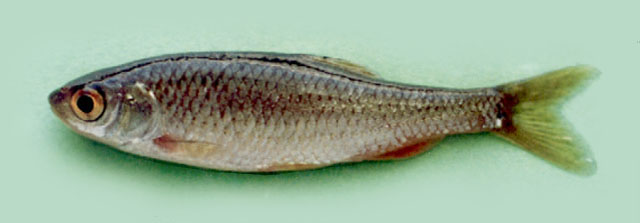| Leuciscidae (Minnows), subfamily: Leuciscinae |
| 40 cm TL (male/unsexed); max. reported age: 8 years |
|
benthopelagic; freshwater; brackish |
| Eurasia: Western, northern and eastern Black Sea and Sea of Azov basins, from Bulgaria clock-wise to Kizilirmak drainage in northern-central Turkey (missing in Don); Aegean Sea basin, from Strma drainage eastward in Europe; northwestern Turkey. In lower reaches of rivers and coastal lakes, but in Dniepr up to Seim and Desna systems. |
|
Dorsal spines (total): 3-4; Dorsal soft rays (total): 8-10; Anal spines: 3-4; Anal soft rays: 9-12; Vertebrae: 36-38. Differs from Petroleuciscus smyrnaeus by having the following characters: dorsal fin with 8-9½ branched rays; ; anal fin with 9-10½ branched rays; iris orange to red; lateral line with 33-40 scales; posterior margin of anal convex or almost straight; without back pigments along free margin of each flank scale (Ref. 59043). |
| Adults inhabit lowland rivers, lower reaches of montane rivers, limans, lakes, deltas, backwaters with moderate to no current. They prefer to stay in warm water with temperatures up to 30-32° C, on sand, sand-mud or mud bottom, and in shallow places with slow current along banks, in backwaters, in small lakes and similar calm-water sites. Can tolerate slightly brackish water and low oxygen concentrations. Feed predominantly on insects and their larvae, but also takes plankton, benthic invertebrates and algae. Form spawning groups of up to 150 individuals. They do not undertake migration but move to deeper places in winter. Sharp decline of some populations is due to drainage of flood-plains and channelization of river beds (Ref. 59043). |
|
Least Concern (LC); Date assessed: 01 January 2008 Ref. (130435)
|
| harmless |
Source and more info: www.fishbase.org. For personal, classroom, and other internal use only. Not for publication.

